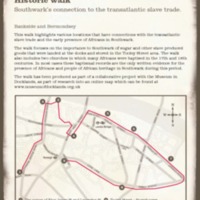
Southwark and Abolition
Southwark Council created two online resources to commemorate the bicentenary. A historic walk, produced in collaboration with the Museum of London Docklands, highlighted locations connected with the slave trade and the early presence of Africans in Southwark. A timeline detailed key dates and events that led to the transatlantic slave trade, including Southwark's local connections to the trade and its abolition. The Cuming Museum in Southwark also held an exhibition, 'Lost and Found'.
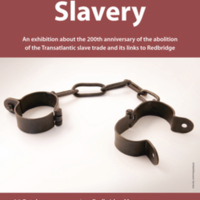
Redbridge and Slavery
Redbridge Museum's exhibition to mark the bicentenary examined the London Borough of Redbridge's connections to the slave trade and abolition. These links included local resident Josiah Child, once Governor of the East India Company, an investor in the Royal African Company and owner of plantations in Jamaica. The Mellish family of Woodford had connections with the West India Docks in London, built for the sugar trade. Alexander Stewart of Woodford owned Jamaican plantations and acted on behalf of owners of enslaved Africans in compensation claims after abolition. The exhibition also examined church records detailing some of the Black residents of Redbridge in the 17th and 18th centuries. Music from the Caribbean island of Dominica was included, as was a series of personal responses to the bicentenary by local residents.
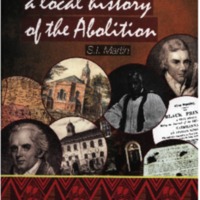
Lambeth and the Abolition
The Lambeth and the Abolition programme included debates, historic trails, a video conferencing discussion between people in Brixton, Ghana and Jamaica, Caribbean family history classes, creative writing workshops, and a dedicated series of events within Black History Month. ‘The Runaways’, an original drama about a runaway slave boy and a kitchen maid in London in 1700, was performed in Lambeth primary schools, accompanied by a workshop. The project researched the local historical links to abolition, and famously the activities of the Clapham Sect (William Wilberforce and his associates) who attended Holy Trinity Church in Clapham. A booklet by historian S. I. Martin sets the history of abolition in the larger context, through his study of the African Academy at Clapham, and his mapping of some of the links between Lambeth, Jamaica and West Africa at the beginning of the 19th century.
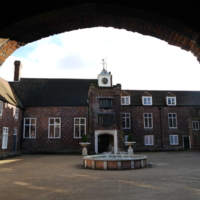
Faces of Freedom: Hammersmith and Fulham and the Slave Trade
The Museum of Fulham Palace is housed in the former palace of the Bishops of London, and former home of Bishop Porteus, the leading advocate for abolition within the Church of England in the late 18th and early 19th centuries. The Faces of Freedom exhibition featured Porteus alongside other individuals associated with slavery and abolition who had links with the area. The abolitionist Granville Sharp lived and is buried nearby, while Crisp Road was named after the slave trader and bead manufacturer Sir Nicholas Crisp. The exhibition included glass beads (very likely produced to be used for barter in Africa) excavated by the Museum of London on the site of Crisp's Hammersmith home. Also featured was the story of Ellen and William Craft, fugitive slaves from Georgia who made Hammersmith their home, and the contributions of local residents Marcus Garvey, Jamaican Pan-Africanist, and nurse Mary Seacole. The exhibition included video footage and posters relating to slavery and freedom, created by pupils from the nearby Phoenix High School.
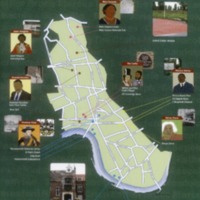
Remembering Slavery in Hammersmith and Fulham
Hammersmith and Fulham Urban Studies Centre is a voluntary educational organisation which offers opportunities to children and young people to learn about the local urban environment. The online curriculum resource 'Remembering Slavery' aimed to inform teaching and learning about the transatlantic slave trade by tracing the links of people and places in Hammersmith and Fulham to enslavement, the slave trade and its abolition. It explored the lives of enslaved Africans and their descendants, detailing their experiences and contributions in the local area. The resource aimed to encourage teachers to develop a locally-based Black history focus across curriculum programmes. It consisted of resource guides and animated films across four broad time frames: pre-Victorian, Victorians, Britain in the 1930s and 40s, and Britain since 1948.
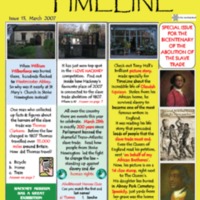
Special issue of TimeLine: Fun and Facts about Stoke Newington and Hackney History and Heritage
TimeLine magazine is a lifelong learning project centred on exploring the history and heritage of Hackney through stories, games, interviews and memories. The magazine is distributed free to schools, libraries and healthcare providers. In March 2007 a special issue of TimeLine examined the bicentenary of the Abolition Act 1807, and Hackney connections to abolition. The special issue included a picture story of the life of Olaudah Equiano.
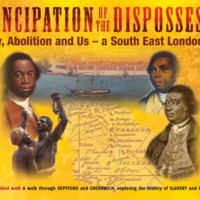
Emancipation of the Dispossessed: Slavery, Abolition and Us - a South East London angle
Emancipation of the Dispossessed was a local community project exploring the local history of Deptford and the surrounding areas and the connections with the transatlantic slave trade. Community groups and students from Lewisham College worked with theatre educators to research and develop 'Blood Sugar', a promenade performance through the Queen's House, Greenwich. The play, written and directed by John Turner, tells the story of slavery and abolition from a local angle, and the script was built around first-hand and eyewitness accounts, campaign pamphlets and reports to parliament. The project also produced learning resources aimed at Key Stage 3 History and Citizenship.
A guided walk explored Deptford’s links to the history of the transatlantic slave trade, uncovering stories of some of the local people who played an important role in the beginnings of the slave trade or the campaign for its abolition. London was an important slave trading port before Bristol and Liverpool dominated the trade. The trade and British colonies were protected by the Royal Navy, whose ships were built and prepared for voyages at the Royal Dockyards at Deptford.
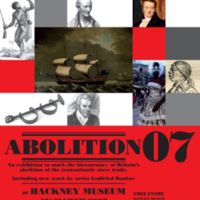
Abolition 07
Hackney Museum's Abolition 07 exhibition told the story of British involvement in the transatlantic slave trade, the resistance to it, and its abolition, and in particular emphasised the involvement of Hackney's residents in the abolition movement. The display included new artwork by Godfried Donkor in collaboration with young Hackney artists. A film of interviews with Hackney residents, Hear My Voice, was produced. Over 1200 children from Hackney Primary Schools took part in poetry workshops at the museum with poets Adisa and Baden Prince. Their poems and responses were published in the booklet 'And Still I Rise'.
The research into Hackney's connections to the transatlantic slave trade continued in 2013-2015 with 'Local Roots / Global Routes', a collaborative project between Hackney Museum and Archives and the Legacies of British Slave-ownership project.
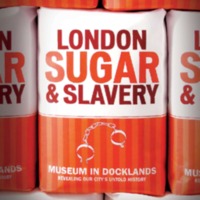
London, Sugar and Slavery
The Museum of London Docklands opened the London, Sugar and Slavery gallery in 2007, and it remains a permanent exhibition. The museum, housed in an old sugar warehouse on London’s West India Dock, retold the narrative of the transatlantic slave trade from the perspective of London, once the fourth largest slaving port in the world. Through personal accounts, film, music, interactive exhibits and over 140 objects, the exhibition looks at the various stages of the transatlantic slave trade, including life and trade on the West India Dock, and conditions for the enslaved on the Middle Passage and the Caribbean plantations. The final section of the gallery focuses on the legacies of the slave trade for British society today. Community collaborations also helped shape the gallery.
The museum also created a walking trail for the local area, highlighting key architectural features and buildings that had a role in the transatlantic slave trade. The Slave Map of London was developed in collaboration with three London museums: the Cuming Museum in Southwark, Bruce Castle Museum in Haringey and Fulham Palace Museum. Users navigated an online map to discover over 100 different locations throughout London which played a part in the transatlantic slave trade and the fight to end it. A schools programme that accompanied the opening of the exhibition included drama performances and workshops. Courses that ran alongside the exhibition in 2007 included ‘Resistance and Achievement: the story of African and Caribbean people in Britain’, in partnership with Middlesex University.
In 2018, the museum reflected on the 10 year anniversary of London, Sugar and Slavery with a workshop to explore the significance of the gallery, with contributions from artists, museum practitioners and emerging artists.
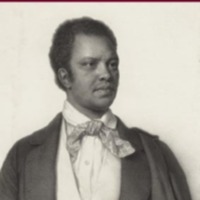
Events to mark the bicentenary in the City of Westminster
In 2007 Westminster City Council supported a programme of events in the libraries, galleries and archives of the area, including films, walks and exhibitions, designed to provide opportunities to learn about the culture of Westminster's communities. Highlights included guided heritage walks with historian S. I. Martin, exhibitions of images from the Royal Geographical Society in Paddington Library, Maida Vale Library and Westminster Reference Library, and film screenings (in partnership with 100 Black Men of London). A partnership between the City of Westminster Archives Centre, Tate Britain, Parliamentary Archives, National Gallery and National Portrait Gallery produced a heritage trail 'On the Road to Abolition: Ending the British Slave Trade', which takes in key sites, events and individuals in Westminster relating to the slave trade, between Trafalgar Square and Pimlico. In celebration of Black History Month, Westminster City Council produced a booklet, 'Black History in Westminster', detailing some of the borough's influential Black residents.
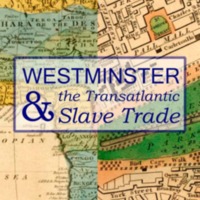
Westminster and the Transatlantic Slave Trade
An exhibition by the City of Westminster Archives Centre focused on the impact of the transatlantic slave trade and its abolition in Westminster, which drew on the Centre's archives and local studies collections. Links explored included the parish of St Anne's Westminster with St John's Antigua, and the large circle of planters living in Marylebone in the 18th and 19th centuries. The exhibition also documented the lives of the African residents of Westminster during the age of the slave trade. Some of the individuals looked at in the exhibition included James Somerset, Granville Sharp, Ignatius Sancho, Ottobah Cugoano, Olaudah Equiano, and the African activists who styled themselves 'Sons of Africa'.
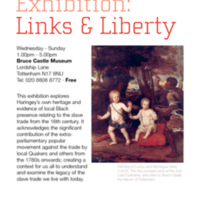
Links and Liberty
An exhibition at Bruce Castle Museum (in partnership with Euroart Studios) explored the transatlantic slave trade, Haringey's heritage relating to the trade and its legacy, and the historic Black presence in the borough from the 16th century onwards. There was a particular focus on the painting of Lucius and Montague Hare, sons of Lord Coleraine (former owner of Bruce Castle), with their African servant. The exhibition also looked at the extra-parliamentary popular movement against the trade by local Quakers such as Priscilla Wakefield and others. Contemporary dance workshops for secondary schools were led by dance company Movement Angol.
The Links and Liberty exhibition included 'Stolen', a life-size installation by artists at Euroart Studios (John Fowler, Lorraine Clarke and Nigel Young) of a section of a slave ship. School pupils were encouraged to climb inside to imagine conditions on board.
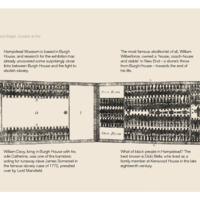
The Transatlantic Slave Trade: Hampstead Connections
An exhibition at Hampstead Museum (based in Burgh House) which examined the connections between Hampstead and slavery. It looked at how fortunes made in the West Indies funded the purchase of properties in this prosperous area, through men like William Beckford and Robert Milligan. Hampstead was also home to men and women tied to the abolitionist movement, such as Samuel Hoare. William Davy, living in Burgh House, was one of the barristers who acted for runaway slave James Somerset in the case of 1772, presided over by Lord Mansfield.
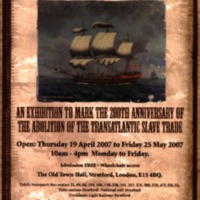
The Wickedest of Cargoes
London Borough of Newham Council led “The Wickedest of Cargoes…”, an exhibition at Stratford Town Hall, which used local museum and archive collections to explore the history of the slave trade and abolition. It looked at the history of slavery through different societies and cultures, and especially the Barbary pirates who enslaved seamen and passengers from ships on the west coast of North Africa. The exhibition explored the transatlantic slave trade and its abolition from a local perspective, focusing on the large Quaker community in West Ham and, in particular, John Fothergill and Samuel Gurney. Newham has many residents from an African Caribbean background, who were consulted in the development of the exhibition. Addressing the legacies of slavery, the exhibition looked at the rising Black population of the borough through history and the importance of the Coloured Men’s Institute in Canning Town, set up as a place where Black families could meet.
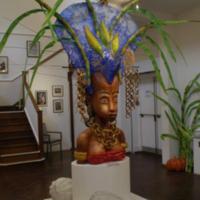
Parallel Views: Black History in Richmond
The Parallel Views exhibition and its associated community engagement programme explored the relevance of the bicentenary for communities in the London Borough of Richmond upon Thames, uncovering local associations with slavery and its abolition. It also told the parallel story of twin town Richmond, Virginia, USA, to broaden understanding of the transatlantic slave trade and the impact of its demise. The exhibition examined evidence of individuals of African origin who had come to Richmond, and residents with financial links to slavery and the slave trade, and to abolitionism. A film piece by choreographer and dance historian Dr Rodreguez King-Dorset explored the use of dance within the free Black community in London during the era of abolition. A display of contemporary artwork responded to the ideas of the exhibition. A sculpture by carnival artist Carl Gabriel linked consumers in Richmond and the conditions of production of slave-grown crops. The design was inspired by a series of workshops with local families. Artist-led workshops for children and young people led to the creation of a carnival costume piece which was included in the exhibition.
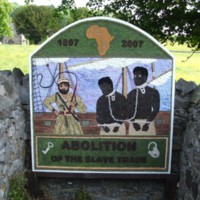
Well Dressings in Derbyshire
Well Dressing is an ancient custom unique to Derbyshire. Each year, between May and September, hundreds of well dressings are created by volunteers in Derbyshire villages. According to many sources, it developed from a pagan tradition of making sacrifice to the Gods of wells and springs to ensure a continued supply of fresh water. In the Derbyshire tradition, pictures are made for the most part of individual flower petals pressed onto clay covered boards. In 2007, many wells were dressed to mark the bicentenary. Pictured are wells in Ashford-in-the-Water, Belper, Tissington and Wirksworth, photographed by Glyn Williams.
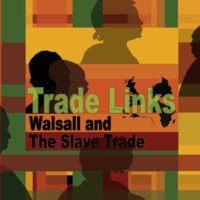
Trade Links: Walsall and the Slave Trade
An exhibition at Walsall Museum looked at Walsall's links with the slave trade, the background to the Abolition Act of 1807, and the legacies of slavery. Walsall's metal industry included chain making by local women of Cradley Heath, and the manufacture of guns used to trade for captive Africans. The exhibition was accompanied by a programme of presentations, lectures and workshops, including art sessions with local residents and the artist Pauline Bailey. Part of the wider project featured an online resource 'Abolition WYA' by Walsall Youth Arts, which encouraged young people to explore the topic of slavery and contribute poems, visual arts and music to express their views. Some of the images featured on the site are pictured here.
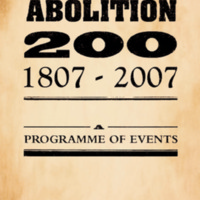
Abolition 200
A programme of events from Wolverhampton City Council to mark the bicentenary, which included a public debate about whether the British government should apologise for the slave trade, services of remembrance and film screenings. Other highlights included stories from Wolverhampton City Archives about the city's role in sustaining the slave trade, and abolishing it, and a discussion and writing workshop with the black writer Fred D'Aguiar and members of Wolverhampton's Black Readers and Writers group. 'Our Ancestors, Our Heritage, Our Stories' was a showcase event highlighting the work of the African Caribbean Community Panel.
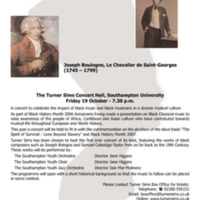
Spirit of Survival: Lives Beyond Slavery
A collaborative project to explore the links between Southampton and the slave trade led by Southampton City Council, the University of Southampton and The Confederation of African Caribbean Communities. One highlight of the programme was a concert at the Turner Sims Concert Hall at the University of Southampton to celebrate the impact of black music and black musicians. The concert, part of Black History Month 2007, featured the works of black composers such as Joseph Bologna and Samuel Coleridge-Taylor, performed by the Southampton Youth Orchestra, Southampton Youth Choir and the Southampton Youth Jazz Orchestra.
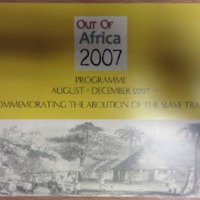
Out of Africa 2007
The African and African Caribbean Kultural Heritage Initiative (ACKHI) is a not-for-profit Black Afrikan-led community organisation, with the aim is to promote, protect and preserve the history, heritage and culture, of peoples of Black African heritage living or working in Oxfordshire. The Out of Africa programme of events in 2007 included an exhibition of books about slavery and the slave trade, which toured Oxfordshire libraries, and performances of African music and contemporary dance. The ‘Remembering Slavery’ commemorative service was held in Christ Church Cathedral. ‘Connections’ was a research project looking at Oxfordshire’s links to the system of slavery and the slave trade. ‘InTentCity’ was a visual arts project, in partnership with Fusion Arts, bringing together cultural groups, primary schools and artists to transform tents into works of art – one theme addressed was ‘Freedom’. Reflecting the legacy of the system of slavery and the slave trade, ‘Common Threads’ was an exhibition of textile work by the Textiles for Peace group, local women representing multi-cultural Oxfordshire. In ‘Ancestral Souls’, the African Women’s Art Collection (AWAC) collaborated with women of African descent to produce and exhibit 200 dolls to represent the diaspora of African peoples.